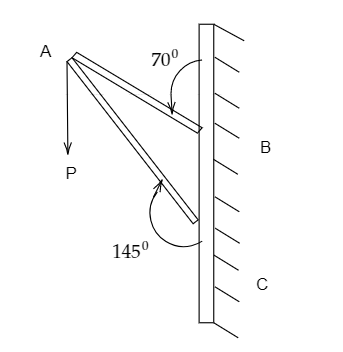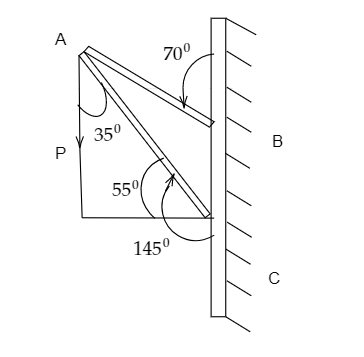
Consider a frame that is made up of two thin massless rods AB and AC as shown in the figure. A vertical force \[\overrightarrow P \]of magnitude 100 N is applied at point A of the frame. Suppose the force \[\overrightarrow P \] is resolved parallel to the arms AB and AC of the frame. The magnitude of the resolved component along the arm AC is x N. Find the value of x, to the nearest integer? [Given: \[\sin ({35^0}) = 0.573\] , \[\cos ({35^0}) = 0.819\] , \[\sin ({110^0}) = 0.939\], \[\cos ({110^0}) = - 0.342\]]

Answer
216k+ views
Hint: Before we proceed into the problem, it is important to know about the resolution of vectors.it is defined as the splitting up of a single vector into two or more vectors in different directions which produces a similar effect as it is produced by a single vector. The vectors which are formed after splitting are called component vectors.
Formula Used:
To find the component along AC we have,
\[{P_{AC}} = P\cos \theta \]…….. (1)
Where, \[{P_{AC}}\] is the vertical force component along AC and P is the vertical force acting on a frame.
Complete step by step solution:
Let’s solve this problem now.

Image: Frame made up of two thin massless rods AB and AC.
In order to find the value of \[\varphi \]we have,
\[\varphi = {180^0} - {110^0} - {35^0}\]
\[\Rightarrow \varphi = {35^0}\]
To find the AC component of P by formula we need the value of\[\theta \]which can be written as,
\[\theta + \varphi = {70^0}\]
\[\Rightarrow \theta = {70^0} - {35^0}\]
\[ \Rightarrow \theta = {35^0}\]
From the equation (1) we are going to find the value of \[{P_{AC}}\]
\[{P_{AC}} = P\cos \theta \]
\[\Rightarrow {P_{AC}} = 100 \times \cos {35^0}\].............(By data we have,\[\cos ({35^0}) = 0.819\])
\[\Rightarrow {P_{AC}} = 100 \times 0.819\]
\[\Rightarrow {P_{AC}} = 81.9N\]
\[\Rightarrow {P_{AC}} = 82N = xN\]
\[ \therefore x = 82\]
Therefore, the value of x is 82.
Note: If any vector quantity is said to be resolved, then it will resolve into two components, one is vertical and other one is horizontal. The vertical component tells us about the upward influence of the force which is applicable in this diagram. The magnitude of a vector basically defines the length of the vector.
Formula Used:
To find the component along AC we have,
\[{P_{AC}} = P\cos \theta \]…….. (1)
Where, \[{P_{AC}}\] is the vertical force component along AC and P is the vertical force acting on a frame.
Complete step by step solution:
Let’s solve this problem now.

Image: Frame made up of two thin massless rods AB and AC.
In order to find the value of \[\varphi \]we have,
\[\varphi = {180^0} - {110^0} - {35^0}\]
\[\Rightarrow \varphi = {35^0}\]
To find the AC component of P by formula we need the value of\[\theta \]which can be written as,
\[\theta + \varphi = {70^0}\]
\[\Rightarrow \theta = {70^0} - {35^0}\]
\[ \Rightarrow \theta = {35^0}\]
From the equation (1) we are going to find the value of \[{P_{AC}}\]
\[{P_{AC}} = P\cos \theta \]
\[\Rightarrow {P_{AC}} = 100 \times \cos {35^0}\].............(By data we have,\[\cos ({35^0}) = 0.819\])
\[\Rightarrow {P_{AC}} = 100 \times 0.819\]
\[\Rightarrow {P_{AC}} = 81.9N\]
\[\Rightarrow {P_{AC}} = 82N = xN\]
\[ \therefore x = 82\]
Therefore, the value of x is 82.
Note: If any vector quantity is said to be resolved, then it will resolve into two components, one is vertical and other one is horizontal. The vertical component tells us about the upward influence of the force which is applicable in this diagram. The magnitude of a vector basically defines the length of the vector.
Recently Updated Pages
JEE Atomic Structure and Chemical Bonding important Concepts and Tips

JEE Amino Acids and Peptides Important Concepts and Tips for Exam Preparation

Electricity and Magnetism Explained: Key Concepts & Applications

Chemical Properties of Hydrogen - Important Concepts for JEE Exam Preparation

JEE Energetics Important Concepts and Tips for Exam Preparation

JEE Isolation, Preparation and Properties of Non-metals Important Concepts and Tips for Exam Preparation

Trending doubts
JEE Main 2026: Application Form Open, Exam Dates, Syllabus, Eligibility & Question Papers

JEE Main Correction Window 2026 Session 1 Dates Announced - Edit Form Details, Dates and Link

Derivation of Equation of Trajectory Explained for Students

Hybridisation in Chemistry – Concept, Types & Applications

Understanding the Angle of Deviation in a Prism

Understanding Collisions: Types and Examples for Students

Other Pages
JEE Advanced Marks vs Ranks 2025: Understanding Category-wise Qualifying Marks and Previous Year Cut-offs

Units And Measurements Class 11 Physics Chapter 1 CBSE Notes - 2025-26

NCERT Solutions For Class 11 Physics Chapter 8 Mechanical Properties Of Solids

Motion in a Straight Line Class 11 Physics Chapter 2 CBSE Notes - 2025-26

NCERT Solutions for Class 11 Physics Chapter 7 Gravitation 2025-26

How to Convert a Galvanometer into an Ammeter or Voltmeter




